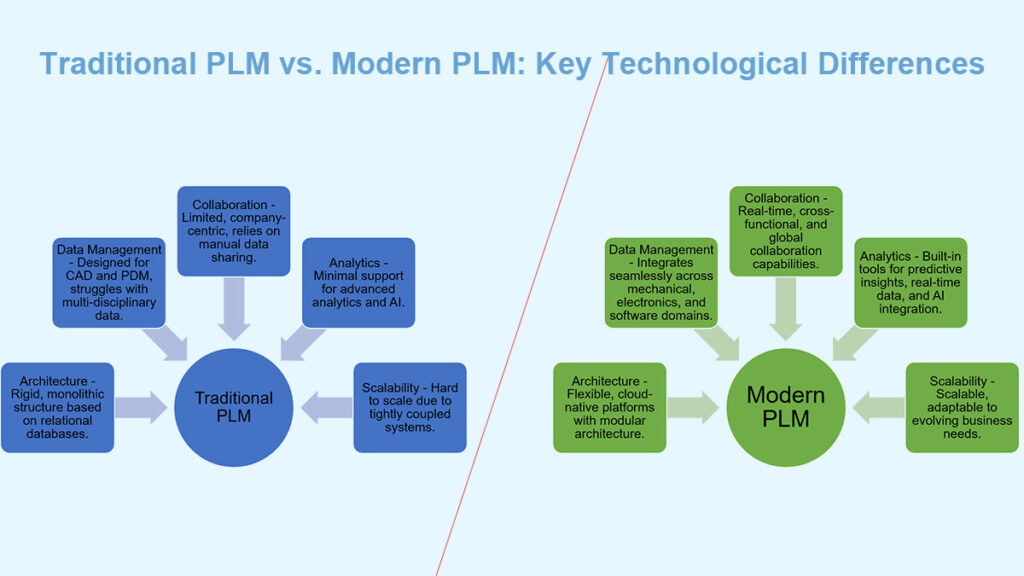
- Why is technology critical in PLM?
- What makes traditional PLM systems challenging?
- How do modern PLM systems address these challenges?
- Why does this matter for NPD/NPI teams and C-Executives?
- What questions should you ask when evaluating PLM technology?
- Moving Forward: The Role of Technology in PLM Success
In the manufacturing industry, where innovation and efficiency drive success, choosing the right Product Lifecycle Management system is a decision that can significantly impact your business. But have you ever considered how much the technology behind your PLM system matters? Let’s explore the technological perspective, comparing traditional and modern PLM systems, and how these differences can shape the future of your operations.
Why is technology critical in PLM?
Think about this: In today’s fast-paced manufacturing world, managing product data, streamlining processes, and enabling cross-functional collaboration are essential for success. Yet, many teams find themselves bogged down by outdated systems. Have you noticed inefficiencies or bottlenecks in your processes? If so, it might be time to assess the technology at the heart of your PLM.
Technology isn’t just a tool—it’s the engine that powers your ability to innovate, adapt, and stay competitive. So, what’s holding many companies back? The answer often lies in their reliance on traditional PLM systems.
What makes traditional PLM systems challenging?
Traditional PLM systems were built for a different era. Here’s a simple analogy: Imagine using a flip phone in today’s smartphone world. It might still make calls, but can it handle video conferences, apps, or cloud storage? Similarly, traditional PLM systems were designed decades ago to manage CAD files and basic product data—and they do that well. But modern manufacturing requires much more.
Key Limitations of Traditional PLM Systems:
Rigid Architecture: Traditional systems rely on relational databases and tightly coupled application logic. This structure is like a house with fixed walls; making changes requires a complete remodel.
Data Silos: They struggle to integrate data from multiple disciplines, such as software, electronics, and mechanical engineering.
Limited Collaboration: Collaboration across global teams or supply chains often requires workarounds like exporting data to Excel.
Minimal Analytics: Advanced analytics, AI, and predictive insights are either unsupported or require costly customizations.
How do modern PLM systems address these challenges?
Modern PLM systems are built to thrive in the digital age. They’re like the latest smartphones: adaptable, connected, and packed with productivity features.
Key Advantages of Modern PLM Systems:
Flexible Architectures: Modern systems use cloud-native platforms and flexible data models, allowing for scalability and easier updates. Think of it as building a modular home where you can add rooms as needed.
Seamless Integration: They integrate seamlessly with diverse data sources and systems, making it possible to manage electronics, software, and mechanical data in one place.
Real-Time Collaboration: Teams worldwide can work on the same data simultaneously, reducing delays and miscommunication.
AI and Analytics: Advanced tools provide predictive insights, helping you make data-driven decisions faster and more effectively.
Why does this matter for NPD/NPI teams and C-Executives?
For NPD/NPI teams, the ability to manage complex product data across disciplines and collaborate in real time can drastically reduce time-to-market. How much could your team accomplish if they had instant access to accurate, up-to-date information?
For C-Executives, the right PLM system isn’t just about operations; it’s about strategy. Modern PLM technology enables better resource allocation, drives innovation, and supports digital transformation goals. Imagine having a system that aligns perfectly with your business vision, empowering your team to achieve more with less.
What questions should you ask when evaluating PLM technology?
When considering your next PLM investment, ask yourself:
Does this system support cloud-native architectures for scalability and flexibility?
Can it handle diverse data types and enable seamless integration?
Does it provide advanced analytics and AI capabilities for better decision-making?
How well does it support collaboration across global teams and supply chains?
Is it future-ready, and adaptable to emerging needs and technologies?
Moving Forward: The Role of Technology in PLM Success
Technology isn’t just about tools; it’s about unlocking potential. Modern PLM systems enable manufacturers to break free from the limitations of traditional systems, fostering innovation, collaboration, and efficiency. The right technology empowers your team to focus on what matters most: delivering exceptional products to market faster and more effectively.
Note: This article is inspired by insights from Oleg Shilovitsky’s thought-provoking blogs on PLM technology. His feedback emphasizes the need to consider how traditional and modern PLM architectures differ and why the technology powering your PLM solution plays a pivotal role in meeting today’s demands.
So, is your current PLM system preparing you for the future or holding you back? The choice of technology is not just a technical decision; it’s a strategic investment in your company’s growth and success.
Let’s embrace the future together. Are you ready to explore how modern PLM technology can transform your business?

